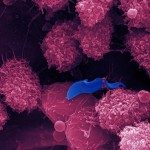Présentation
Dynamics of the early steps of mammalian host infection by African trypanosomes
Human African Trypanosomiasis or sleeping sickness is a neglected tropical disease caused by the flagellated protist Trypanosoma brucei. Nagana is a similar disease in cattle due to closely related trypanosome species. The injection of these extra-cellular parasites by the bite of the tsetse fly induces a local inflammatory response. Trypanosomes then apparently transit via the lymphatic system before invading the bloodstream where they proliferate and cause the typical symptoms of the disease. However, very little is known about the early steps of infection, especially the mechanisms of trypanosome differentiation, proliferation and passage to the bloodstream. The first aim of this project is to characterize these early steps of T. brucei development upon natural transmission of a fluorescent strain by a tsetse fly bite using state-of-the-art intravital imaging technologies. Particular attention will be paid to parasite motility, proliferation, morphogenetic modifications and interactions with host cells. The second goal is to establish the importance of the trypanosome flagellum that has been proposed to be a key virulence factor. Functional investigations with conditional knockout parasites will be performed to discover the role of (1) flagellum motility in migration towards specific tissues and avoidance of host immune cells, by using mutants deprived of a specific component of the flagellum axoneme dynein motor (LC1), and of (2) flagellum sensory functions in detection of the environment and activation of the appropriate differentiation programs, by targeting two types of proteins. The first target is a group of aquaporin channels (AQP1-3) enriched at the flagellum and flagellar pocket membranes, potentially involved in detection of small uncharged solutes such as glycerol in the environment. The second target is a protein of unknown function called FLAM8 that is concentrated at the distal tip of the flagellum. Overall, these studies will result in the first integrated view of the early steps of trypanosome infection and will be crucial to improve early diagnosis and treatment of this disease that is always fatal in the absence of treatment.






